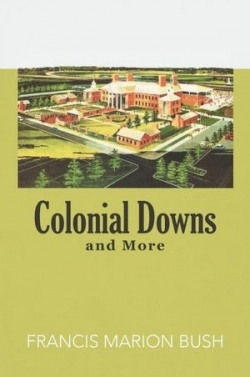Colonial Downs and More
Horse racing has charmed spectators for centuries. The flashing colors, the flying clods of dirt, the foamy sheen on the muscled bodies of horses who look like they’re enjoying themselves, and the thrill of victory make the fans in the stands feel like part of the proceedings. The stories are important too. Stories about horses, trainers, jockeys, and the tracks on which the pageantry plays out are part of what make horse racing a popular sport.
Francis Marion Bush knows the power of these stories and has filled a book with tales specifically about Colonial Downs, a racetrack in Virginia. A member of the Virginia Thoroughbred Association, Bush has been involved with horses since he was a boy, and he has put his passion for the sport into several books about horses and racing.
In Colonial Downs and More, he turns his attention to Colonial Downs, which opened in 1997. He chronicles the legislative acts that had to pass before Colonial Downs could be built, the struggle with opposition to the track and to wagering, the major players in the building and running of the track, and even the horses that have raced there.
Bush presents a well-researched catalogue of events, people, and horses. His biographical sections are perhaps the most entertaining, especially when they include photos of advertisements for races that took place decades ago. Within these paragraphs, Bush’s sense of history shines through: “The Varina Volunteer Fire Department sponsored the ‘Varina Races’ for three years. Monies benefited the Fire Department. Once Henrico County assumed the management of the Fire Department, the Varina Lions Club sponsored the event. Monies went for Sight Conservation, a local charity.”
However, the book seems narrowly targeted to an audience directly involved with racing at Colonial Downs. Though he mentions attending races as a child and being part of the racing world in Virginia, he does not offer any personal anecdotes of life on the track or attempt to relay the sensations associated with the sport, which might interest readers who’ve never been to a race. Instead, he focuses exclusively on names, dates, legal issues, and opposition to the building of Colonial Downs. Very few people beyond those involved in the track will find these details interesting or relevant.
Bush’s prose is lucid but not inviting. For example, “Point-to-point meets are great proving grounds. Most are excellent community fundraisers. Owners compete for trophies. If their horses race well, owners enter them in steeplechase races to win money.” Most of the text is delivered in this staccato manner, which can be tedious to read. Horse racing is a dynamic sport that lends itself to dynamic prose. Bush misses an opportunity to make his book appealing to a wider audience by sticking so closely to bare facts.
Nonetheless, Colonial Downs and More is a well-researched book about a very specific topic. To be sure, Bush knows his racing world!
Reviewed by
Andi Diehn
Disclosure: This article is not an endorsement, but a review. The publisher of this book provided free copies of the book and paid a small fee to have their book reviewed by a professional reviewer. Foreword Reviews and Clarion Reviews make no guarantee that the publisher will receive a positive review. Foreword Magazine, Inc. is disclosing this in accordance with the Federal Trade Commission’s 16 CFR, Part 255.

